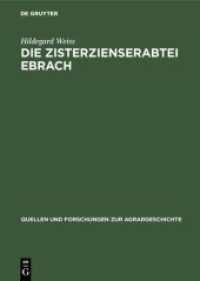- ホーム
- > 洋書
- > ドイツ書
- > Humanities, Arts & Music
- > History
- > antiquity
Description
(Short description)
(Text)
(Text)
worden. Im Mittelpunkt steht der Sammlungsbestand des Archäologischen Nationalmuseums von Karthago, der um Funde aus verschiedenen Museen des östlichen Algerien und westlichen Libyen (u. a. Djemila, Timgad und Sabratha) ergänzt werden konnte. Der erste des auf zwei Bände angelegten Werkes beinhaltet die Funde der spätesten römischen Kaiserzeit und der vandalischen Zeit (um 400 bis mittleres 6. Jahrhundert n. Chr.). Nur zum kleineren Teil handelt es sich bei den rund 190 Objekten um geschlossene Grab- oder stratitifizierte Siedlungsfunde. Die Mehrheit bilden Altfunde, die zumeist ohne bekannten Kontext geborgen wurden, aber wegen ihrer formenkundlichen Vielfalt und ihrer Anzahl von großer Bedeutung sind. Neben einer ausführlichen formenkundlich-chronologischen Analyse, die den regionalen und überregionalen Zusammenhang des Fundmaterials aufzeigt, nimmt die weitere Auswertung Fragen zum Trägerkreis und seiner kulturellen und ethnischen Zuordnung in den Blick. So wird untersucht, inw
(Short description)
This study is the first to give a comprehensive account of extant dress accessories, especially brooches and belt buckles, from late ancient North Africa. In the first of two volumes, the findings dating from the latest period of Roman rule and the Vandalic period following it are presented, most of which were not published before. In addition to aspects of the chronology and geographical distribution of these findings, which are of high importance for protohistoric and Provincial Roman archaeology, the study will focus on questions about the wearers and their cultural identity.
This study is the first to give a comprehensive account of extant dress accessories, especially brooches and belt buckles, from late ancient North Africa. In the first of two volumes, the findings dating from the latest period of Roman rule and the Vandalic period following it are presented, most of which were not published before. In addition to aspects of the chronology and geographical distribution of these findings, which are of high importance for protohistoric and Provincial Roman archaeology, the study will focus on questions about the wearers and their cultural identity.








